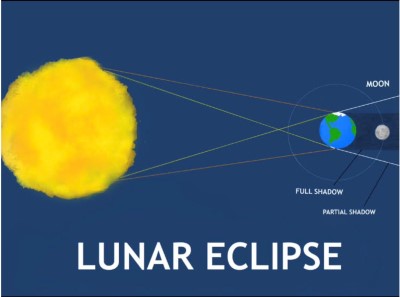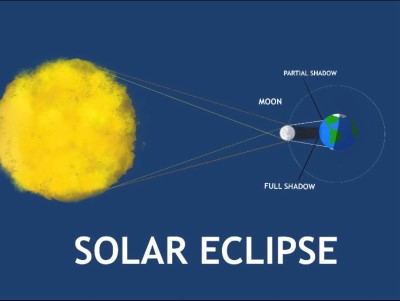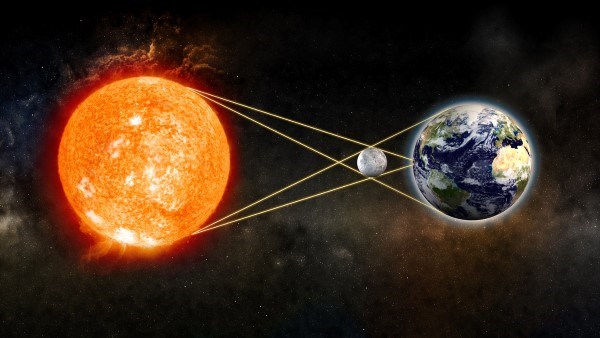Civilizations have observed and documented eclipses for as long as humans have roamed the Earth. Myths and superstitions regarding the impact of eclipses have existed for millenia.
In ancient China, they believed that an eclipse was caused by a dragon trying to eat the sun. A Vietnamese legend proclaims that a giant frog eats the sun while trying to escape his master. The Greeks believed that eclipses occurred when gods were angry with humans. The Inuit people believe that an eclipse occurs when the moon god Anningan catches up with the sun goddess Malina after an argument, during which the sun goddess walks away.1
Our understanding of the cause of these eclipses has changed with time. A solar eclipse occurs when the moon passes between the sun and the Earth, casting the moon’s shadow on Earth. A lunar eclipse occurs when the Earth is between the sun and moon, causing the sun to cast Earth’s shadow onto the moon. A total lunar eclipse lasts a few hours because of the large size of Earth in comparison to the moon. Meanwhile, a solar eclipse is very brief, lasting seconds to minutes.


There are also Mercury and Venus transits, which occur when Mercury or Venus cross directly between the sun and Earth. These are both very rare events.2-3
Today’s society often associates celestial phenomena with a harbinger that something bad is on the verge of happening.4 However, previous research examining the relationship between the moon’s phases and incidence of ED-related trauma has found a weak link: Thompson et al, for example, found no statistically significant difference in the number of emergency department patient visits, ambulance runs, or ED admissions between full moon and non-full moon days.5 Similarly, Coates et al also found no statistically significant difference in number of trauma admissions.6Harstone-Rose et al examined the behavior of 17 animal species at a South Carolina zoo during a solar eclipse. While abnormal behavior was observed in 13 of the 17 species, behavior described as “anxious” was observed in only 5 species. The most extreme examples included a giraffe and baboon who paced back and forth for more than an hour after the eclipse ended.7
Yet no research study has ever examined how eclipses — solar or lunar — or planetary transits impact volume and acuity of patients presenting to the emergency department.
The aim of our study is to examine how eclipses affect human behavior in terms of emergency department visits and acuity.
Methods
This was a 7-year retrospective, observational, case-control study performed by querying the electronic medical record and trauma registry from Jan. 1, 2016, to Dec. 31, 2022, at a large county hospital with more than 900 beds in Florida.
Eclipse days were defined as a solar eclipse, lunar eclipse, or mercury transit visible in our geographical region.8 The following conditions were searched for on days of eclipses and averaged over the 7-year period:
- emergency department census
- hospital admissions
- ambulance arrivals
- number of visits for altered mental status
- suicidal ideation
- drug overdose
- strokes
- cardiac arrests
- births
- falls
- total trauma activations
- level 1 trauma activations
- level 2 trauma activations
- gunshot wounds
- stabbings
- motor vehicle accidents
An unpaired T-test was performed using social science statistical software.9 Statistical significance was defined as a p-value less than 0.05. Institutional ethical approval was obtained for this study from the Institutional Review Board at the hospital.
Results
From Jan. 1, 2016, to Dec. 31, 2022, there were 767,220 visits to the emergency department, 476,517 hospital admissions, and 121,331 ambulance arrivals.
During the 7-year period, there were 6,376 individuals treated following motor vehicle accidents, 21,093 falls, 27,560 births, 1,687 cardiac arrests, 102 gunshot wounds, 9,571 strokes, 281 stabbings, 15,355 trauma activations, 2,248 level 1 trauma activations, 13,107 level 2 trauma activations, 10,434 visits for altered mental status, 5,182 for suicidal ideation, and 1,918 for drug overdose.
There were 13 eclipses during this time: 2 mercury transits, 10 lunar eclipses, and 1 solar eclipse. On average, there were 309.85 visits to the ED on eclipse days, and 300.28 visits on no-eclipse days.
There were averages of 299.3 visits on lunar eclipse days, 347.5 visits on mercury transit days, and 340 visits on the single solar eclipse day.
There were averages of 0.54 strokes and 4.62 falls on eclipse days, whereas there were 3.75 strokes and 8.26 falls on no-eclipse days.
Average numbers of births, level 1 trauma activations, gunshot wounds, stabbings, visits for motor vehicle accidents, stroke, cardiac arrest, and suicidal ideation were all higher on days without an eclipse.
There were more hospital admissions and drug overdoses on eclipse days.
Table 1: ED Volume and Visits by Eclipse vs. No-Eclipse Days
|
Average Number Per Day |
No Eclipse |
Eclipse |
Lunar |
Solar |
Mercury |
P-value comparing Eclipse to No-Eclipse Visit Numbers |
|
ED Visits |
300.28 |
309.85 |
299.30 |
340.00 |
347.50 |
0.2746 |
|
Hospital Admissions |
186.50 |
191.92 |
178.40 |
192.00 |
210.00 |
0.4968 |
|
Ambulance Arrivals |
47.49 |
47.45 |
46.56 |
49.00 |
54.00 |
0.4115 |
|
Strokes |
3.75 |
0.54 |
0.70 |
0.00 |
0.00 |
< 0.00001 |
|
Cardiac Arrests |
0.66 |
0.15 |
0.20 |
0.00 |
0.00 |
0.0060 |
|
Births |
10.79 |
10.46 |
9.40 |
18.00 |
12.00 |
0.4312 |
|
Drug Overdoses |
0.75 |
1.00 |
0.80 |
3.00 |
1.00 |
0.2774 |
|
Suicidal Ideation |
2.03 |
1.46 |
1.46 |
0.00 |
0.00 |
0.3304 |
|
Total Trauma Activations |
6.01 |
6.62 |
6.20 |
6.00 |
9.00 |
< .00001 |
|
Level 1 Trauma Activations |
0.88 |
0.61 |
0.50 |
0.00 |
1.50 |
< .00001 |
|
Level 2 Trauma Activations |
5.13 |
6.00 |
5.70 |
6.00 |
7.50 |
< .00001 |
|
Gunshot Wounds |
0.04 |
0.00 |
0.00 |
0.00 |
0.00 |
< .00001 |
|
Assaults with a Sharp Object |
0.11 |
0.08 |
0.10 |
0.00 |
0.00 |
< .00001 |
|
Motor Vehicle Accidents |
2.50 |
1.46 |
1.90 |
0.00 |
0.00 |
0.1794 |
|
Falls |
8.26 |
4.62 |
6.00 |
0.00 |
0.00 |
0.2097 |
Discussion
A significantly lower number of trauma and stroke patients were seen on eclipse days compared to days without an eclipse. On no-eclipse days, there were more visits for falls, births, motor vehicle accidents, cardiac arrests, and suicidal ideation — although the difference was not significant. A non-significant volume of patients was seen on eclipse days, with an average of 309.85 patients vs. 300.28 on no-eclipse days.
A significantly higher number of trauma patients was seen on eclipse vs. no-eclipse days. Total numbers of trauma activations, level 1 trauma activations, gunshot wounds, and stabbings all were significantly higher. There were more visits for motor vehicle accidents on no-eclipse days, but the difference was not significant.
The number of ambulance arrivals was similar on eclipse and no-eclipse days at 47.45 and 47.49, respectively. More patients were admitted on eclipse days than no-eclipse days, although the results were not statistically significant. Similarly, there was a non-significant higher number of drug overdoses on eclipse days.
Limitations
This study had several limitations. First, the study was underpowered as the sample size was quite low, given there were only 13 eclipses — including just 2 mercury transits and 1 solar eclipse. Overall, the low volume of penetrating trauma presenting to the emergency department likely resulted in sampling bias and chance association as demonstrated by the lower numbers of traumatic visits on eclipse days. Other confounding variables included the day of the week and weather, which likely influenced the acuity and volume of presenting patients.
A multicenter study across a diverse geographical region would be ideal to further elucidate the relationship between emergency department visits and the occurrence of an eclipse.
The driving factor for the higher patient volume on eclipse days is unclear. As mentioned above, sampling bias may be a factor, given the association did not reach significance. An interesting part of the study involves examining the data from the single solar eclipse. The local area experienced approximately 80% totality — meaning 80% of the sun’s surface was obscured by the moon. This event was considered a once-in-a-lifetime phenomenon, as a solar eclipse occurs in the same location once every 375 years.7 On the day of the solar eclipse, there were higher numbers of births, drug overdoses, ED visits, ambulance arrivals, and hospital admissions compared to no-eclipse days, but the numbers of trauma activations, strokes, and cardiac arrests were all lower.
Conclusion
Ultimately, the results of our study suggest that the presence of an eclipse did not detrimentally affect human behavior. Human beings are sentient individuals capable of responding to their environment out of their own free will, rather than being driven by astrological phenomena. Despite a significantly higher number of trauma activations and penetrating traumas on eclipse days, the absolute difference is quite minimal, and it is apparent that the volume and acuity of patients presenting to the emergency department is relatively unaffected by the presence of an eclipse.
In this 7-year retrospective, observational, case-control study involving 767,220 visits to the emergency department, no significant differences were noted between the volume or acuity of patients on eclipse and no-eclipse days. The overall number of ED visits on eclipse days was insignificantly higher; however, the numbers of trauma activations, gunshot wounds, and stabbings were all significantly lower on eclipse days.
References
- Who ate the sun? 5 variations on ancient solar eclipse myths. The Times and Democrat. Published June 27, 2017. Accessed December 2, 2023. https://thetandd.com/who-ate-the-sun-5-variations-on-ancient-solar-eclipse-myths/article_56facfd9-9902-5e52-b85a-0e91aee509d5.html
- Fischetti MM. 1,000 Years of Solar Eclipses. Sci Am. 2017 Jul 16;317(2):62-65.
- US Department of Commerce N. Solar and Lunar Eclipses. https://www.weather.gov/fsd/suneclipse
- Eclipse Misconceptions | Total Solar Eclipse 2017. eclipse2017.nasa.gov. https://eclipse2017.nasa.gov/eclipse-misconceptions
- Thompson DA, Adams SL. The full moon and ED patient volumes: Unearthing a myth. The American Journal of Emergency Medicine. 1996;14(2):161-164.
- Coates W, Jehle D, Cottington E. Trauma and the full moon: A waning theory. Annals of Emergency Medicine. 1989;18(7):763-765.
- Hartstone-Rose A, Dickinson E, Paciulli LM, Deutsch AR, Tran L, Jones G, Leonard KC. Total Eclipse of the Zoo: Animal Behavior during a Total Solar Eclipse. Animals (Basel). 2020 Mar 31;10(4):587.
- Eclipses visible in Sarasota, Florida, USA. https://www.timeanddate.com/eclipse/in/usa/sarasota
- Social Science Statistics. T-Test Calculator for 2 Independent Means. Socscistatistics.com. Published 2019.



